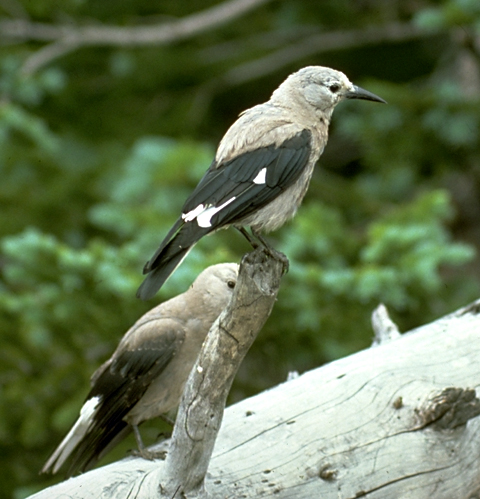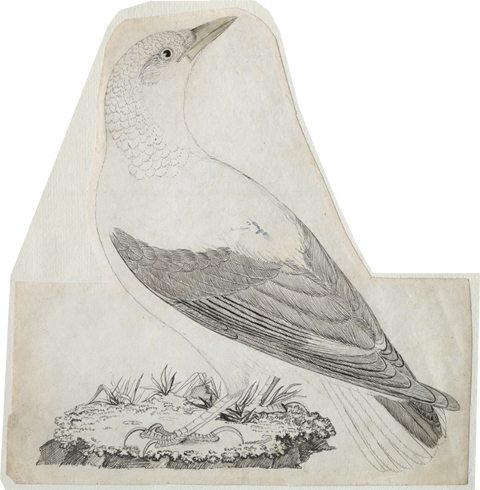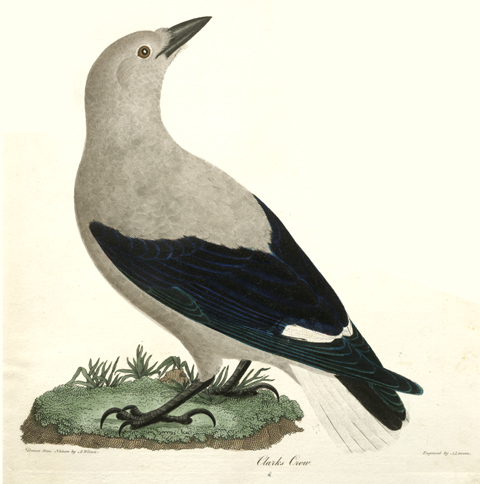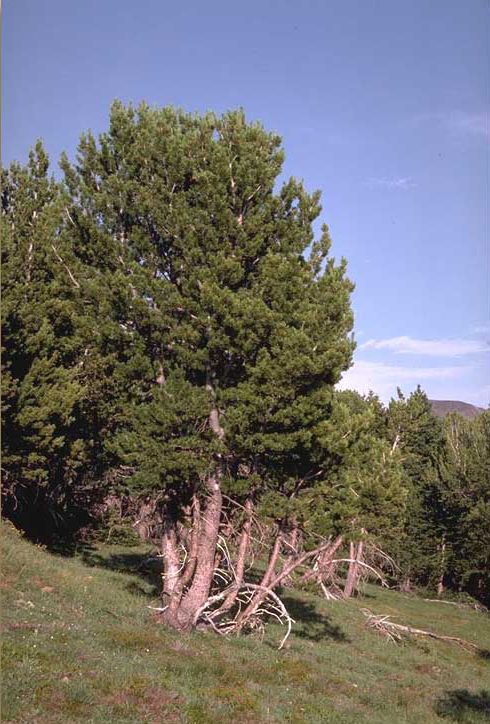Encounter and Description
On 22 August 1805, William Clark was struggling down the canyon of the Salmon River, testing the Indians’ warning that it could not be floated. Though his attention was mainly directed toward the topography, and the Indians he met at the North Fork of the Salmon, he noticed a new bird:
I saw to day [a] Bird of the woodpecker kind which fed on Pine burs it’s Bill and tale white the wings black every other part . . . .
On 28 May 1806, while camped at Weippe Prairie, waiting for the snow-choked Indian trail across the Bitterroot Mountains to thaw out, Meriwether Lewis had time to study and describe it with his usual thoroughness, immediately correcting Clark’s error as to the bird’s taxonomy:
since my arrival here I have killed several birds of the corvus genus of a kind found only in the rocky mountains and their neighbourhood. [it] has a loud squawling note something like the mewing of a cat. the beak of this bird is 1-1/2 inches long, is proportionably large, black and of the form which characterizes this genus. the upper exceeds the under chap [beak; properly, mandible] a little. the head and neck are also proportinably large. the eye full and reather prominent, the iris dark brown and puple black. it is about the size and somewhat the form of the Jaybird tho reather rounder or more full in the body. the tail is four and a half inches in length, composed of 12 feathers nearly the same length. the head neck and body of this bird are of a dove colour. the wings are black exccept the extremities of six large f[e]athers occupying the middle joint of the wing which are white. the under disk of the wing is not of the shining or g[l]ossy black which marks its upper surface. the two feathers in the center of the tail are black as are the two adjacent feathers for half their width the ballance are of a pure white. the feet and legs are black and imbricated with wide scales. the nails are black and remarkably long and sharp, also much curved. it has four toes on each foot of which one is in the rear and three in front. the toes are long particularly that in the rear. This bird feeds on the seed of the pine and also on insects. it resides in the rocky mountains at all seasons of the year, and in many parts is the only bird to be found.
Wilson’s Drawing
Alexander Wilson (1766-1813), the pioneer American ornithologist, drew the original pencil sketch of “Clark’s Crow,” and may have applied the watercolors to the engraving Alexander Lawson (1772-1846) made from it for Wilson’s book, American Ornithology.[1]Alexander Wilson, American Ornithology or, The natural history of the birds of the United States: Illustrated with plates, engraved and colored from original drawings taken from nature, 9 vols. … Continue reading The original size of the copperplate engraving was approximately 12.5 x 13.6 in.
Clark’s namesake bird does indeed belong to the family Corvidae (“crows”), along with jays, magpies, ravens, and common crows. Wilson classified it in the genus Corvus; John James Audubon changed that to Nucifraga, meaning “nut breaker,” and the species columbiana, “of the Columbia” River. The specific epithet is appropriate inasmuch as Clark first mentioned it on “Lewis’s River”—i.e., the Salmon River—which is one of the headwaters of the Columbia. Today it is known to most people as Clark’s nutcracker. He originally grouped it with two other birds closely associated with the two explorers, the western tanager and Lewis’s woodpecker. They were:
but a small part of the valuable collection of new subjects in natural history discovered and preserved, admidst a thousand dangers and difficulties, by those two enterprising travellers whose intrepidity was only equalled by their discretion, and by their active and laborious pursuit of whatever might tend to render their journey useful to science and to their country. It was the request and particular wish of Captain Lewis, made to me in person, that I should make drawings of such of the feathered tribes as had been preserved, and were new. That brave soldier, that amiable and excellent man, over whose solitary grave in the wilderness I have since shed tears of affliction, having been cut off in the prime of his life, I hope I shall be pardoned for consecrating this humble note to his memory, until a more able pen shall do better justice to the subject.
Wilson explained that “the figure in the plate was drawn with particular care, after a minute examination and measurement of the only preserved skin that was saved; and which is now deposited in Peale’s Museum.”
It seemed to Wilson that the new bird somewhat resembled the Jackdaw of Europe (Corvus monedula)—”several of the party supposing it t be the same”—but noted that “its formidable claws, which approach to those of the Falco genus . . . . would seem to intimate, that its food consists of living animals, for whose destruction these weapons must be necessary. He learned first-hand from “different individuals of Lewis and Clark’s party” that it frequented rivers and the seashore, and probably ate fish.[2]American Ornithology, edited by George Ord (3 vols., 1828), 1:180.
Wilson was wrong, of course, but he had only his notes from conversations with Lewis and others, such as George Shannon, and had not gone to the Northwest to see for himself. Nor could he benefit from the appropriate entries in either Clark’s or Lewis’s journals. Clark’s nutcracker is found from the east slopes of the Coast Ranges to the Rockies, mainly at high elevations, where it favors the seeds of the whitebark pine. It does not frequent the seashore, nor is it a fish-eater, but it is opportunistic, which certainly earned it the common epithet “camp robber,” and it does feed on carrion, a habit that possibly gave rise to the nickname “meat hawk” in some quarters. However, its favorite food is the seed of the subalpine whitebark pine.[3]Tomback, D. F. 1988. Clark’s Nutcracker (Nucifraga columbiana). In The Birds of North America, No. 331 (A. Poole and F. Gill, eds.). The Birds of North America, Inc., Philadelphia, PA. In retrospect, the misunderstanding simply underscores the importance of naturalists’ and artists’ follow-ups of Lewis and Clark’s discoveries.
Relationship with Whitebark Pine
Lewis’s closeup view of Clark’s nutcracker is certainly complete, and his recognition of its membership in the crow family is correct. But there’s more to the story, and it’s still being written. This bird’s ancestors have been squalling around the Rocky Mountains boisterously for at least twelve million years, just doing their job. Returning a favor. Growing trees. In fact the Clark’s nutcracker is wedded for better or worse to the whitebark pine.
The whitebark pine is tough. It lives in dry, rocky soils on exposed slopes and ridges in the sub-alpine zone of the Northern Rockies, up to about 10,000 feet, and it’s designed to withstand the rigors of life at those heights. Some of the whitebark pines standing on the ridges along the Continental Divide today may have been many years old when the expedition passed by. But this tree has a problem. It produces seed-cones about once every four or five years, which don’t open until they decay, which can take a long, long time up there.
Clark’s nutcracker is a similarly hardy creature; with luck it may reach the hoary old age of twelve years or more. It likes living at subalpine elevations, and nesting in whitebark pines (in February!), but to survive it needs fatty foods such as the seeds held fast in the whitebark pine’s cone. So the nutcracker is equipped with a bill like a crowbar, to pry them from the cones.
In a pouch in its throat, the bird can carry up to several dozen seeds to bury in the ground for a later appetite—a whitebark seedbank; a nutcracker foodbank.
The bird hides its seeds in a number of caches spread out over a radius of up to several miles. On average, it eats only about two-thirds of the seeds it saves, but it buries them all at just the right depth for some of the leftovers to germinate. This explains why whitebark pines often grow in clusters.
Challenges
There are other dividends in this fruitful companionship. Together, the bird and the tree create a home for other animals: red squirrels, grosbeaks, and Steller’s jays. Grizzly and black bears dig up the nutcracker’s leftovers when they prepare for hibernation. For thousands of years, and until long after Lewis and Clark were gone, even native people shared the whitebark pine’s wealth, grinding the seeds into rich flour.
Since the early 20th century, however, people with different values have changed the terms of this nuptial contract between bird and tree. Trees have come to be thought of as cash crops, and fire, nature’s household cleanser and garden herbicide, has been an enemy to be suppressed. As a result, subalpine fir trees—weeds of the woods, having no commercial value—have moved in and taken over the whitebark pine’s neighborhood. The whitebark pine isn’t commercially important either, so few people notice when the whitebark loses ground, or when Clark’s nutcracker goes hungry.
Better is coming to worse.
Further Reading
Ronald M. Lanner, Made for Each Other: A Symbiosis of Birds and Pines. New York: Oxford University Press, 1996.
Notes
| ↑1 | Alexander Wilson, American Ornithology or, The natural history of the birds of the United States: Illustrated with plates, engraved and colored from original drawings taken from nature, 9 vols. (Philadelphia: Bradford & Inskeep, 1808-1814), 1:321-22 and Plate 20. |
|---|---|
| ↑2 | American Ornithology, edited by George Ord (3 vols., 1828), 1:180. |
| ↑3 | Tomback, D. F. 1988. Clark’s Nutcracker (Nucifraga columbiana). In The Birds of North America, No. 331 (A. Poole and F. Gill, eds.). The Birds of North America, Inc., Philadelphia, PA. |
Experience the Lewis and Clark Trail
The Lewis and Clark Trail Experience—our sister site at lewisandclark.travel—connects the world to people and places on the Lewis and Clark Trail.
Discover More
- The Lewis and Clark Expedition: Day by Day by Gary E. Moulton (University of Nebraska Press, 2018). The story in prose, 14 May 1804–23 September 1806.
- The Lewis and Clark Journals: An American Epic of Discovery (abridged) by Gary E. Moulton (University of Nebraska Press, 2003). Selected journal excerpts, 14 May 1804–23 September 1806.
- The Lewis and Clark Journals. by Gary E. Moulton (University of Nebraska Press, 1983–2001). The complete story in 13 volumes.






